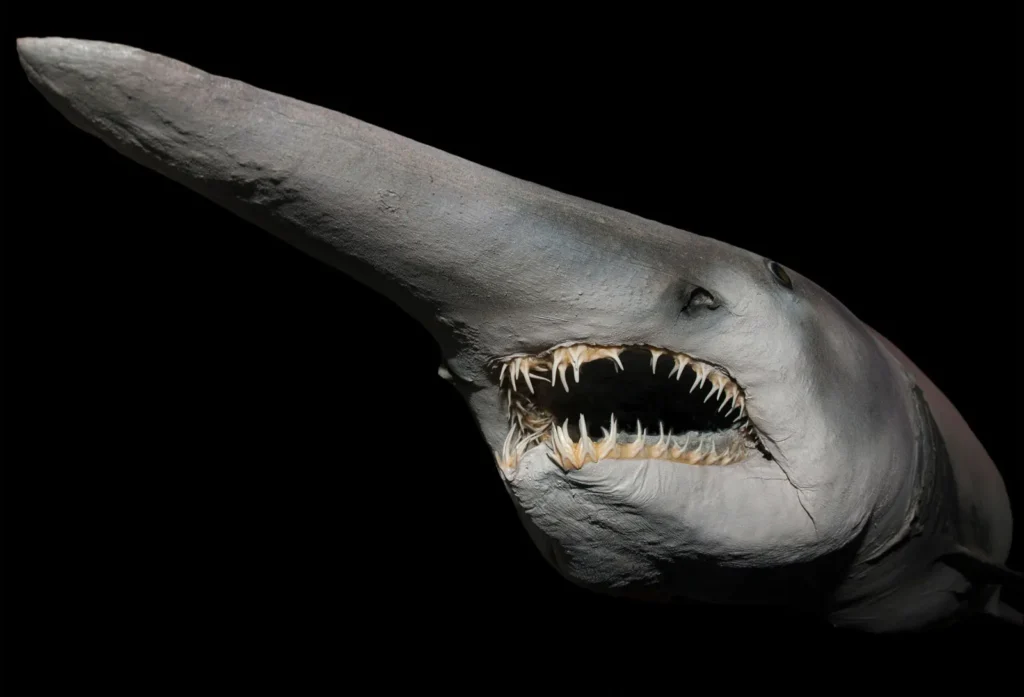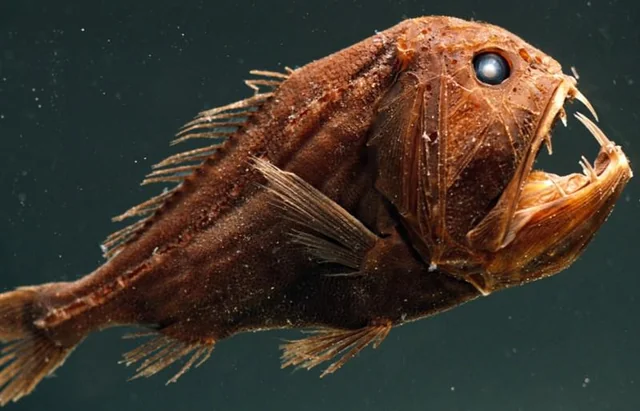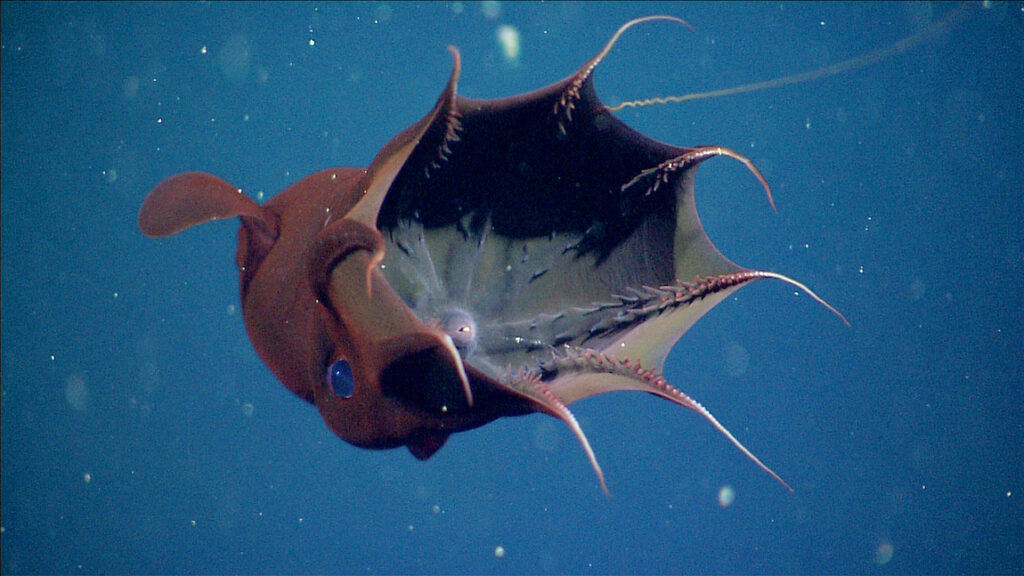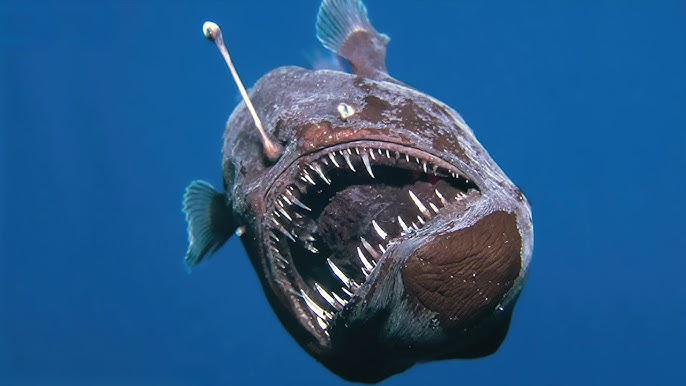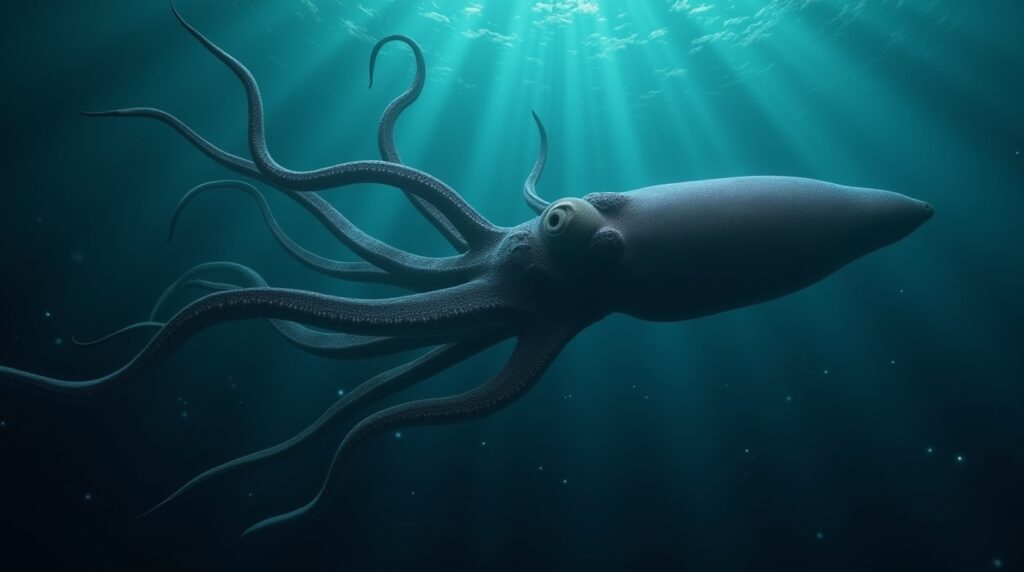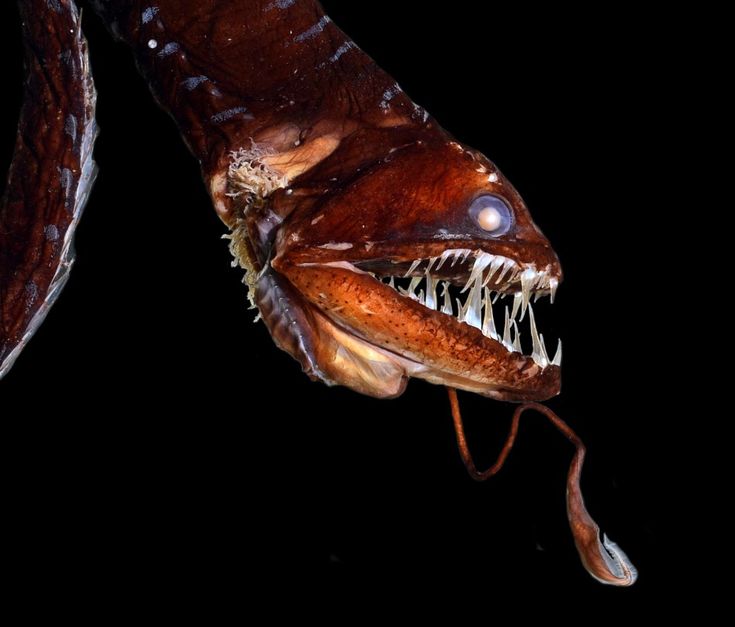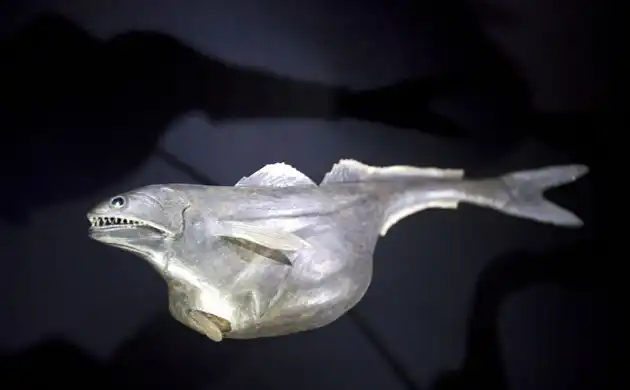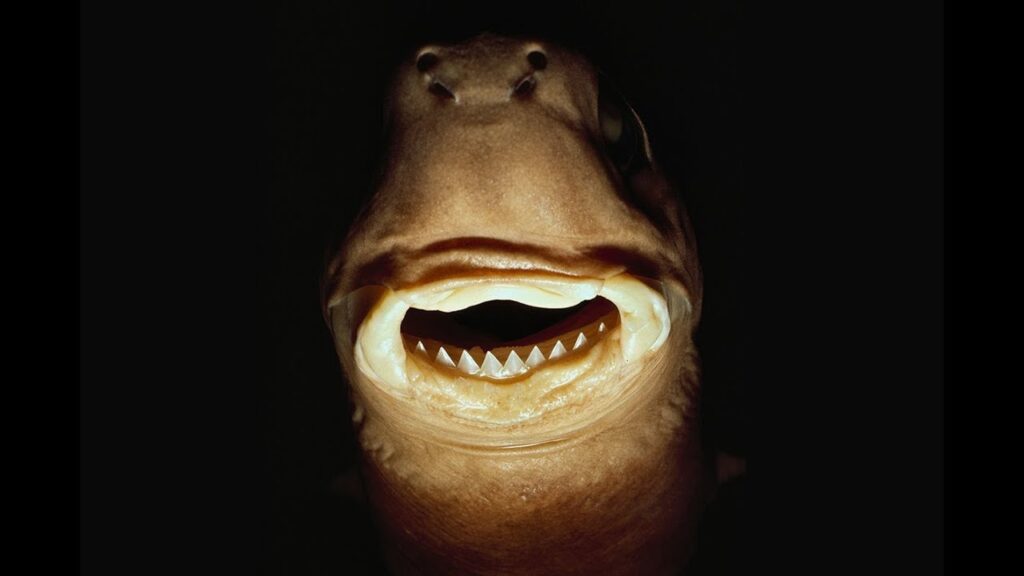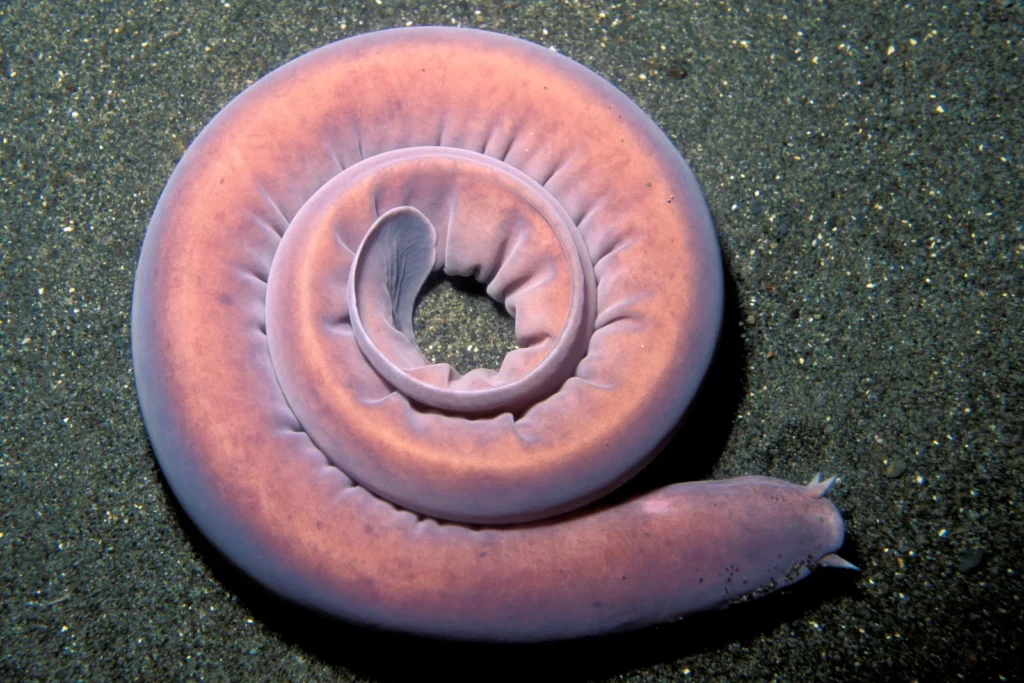The deep sea is one of the most mysterious and least explored places on Earth. With crushing pressures, near-freezing temperatures, and total darkness, it’s a world that’s more alien than familiar. But what’s even more fascinating—and terrifying—are the creatures that live there. Many of them have adapted in bizarre, jaw-dropping, and sometimes deadly ways.
Ready to dive into the abyss? Here are the Top 10 Deadliest Deep Sea Creatures lurking far below the ocean’s surface.
1. Goblin Shark
Scientific Name: Mitsukurina owstoni
Depth: 100–1,200 meters (328–3,937 ft)
Nicknamed the “living fossil,” the goblin shark looks like it swam straight out of a horror film. Its long snout is filled with electroreceptors, and when it detects prey, its jaw literally launches forward like something from Alien. While attacks on humans are rare, its sudden, spring-loaded bite is capable of tearing into flesh with razor-sharp teeth.
Why it’s deadly: Spring-loaded jaws, sharp teeth, and the ability to sense electric fields make this shark a terrifying predator in the deep.
2. Fangtooth Fish
Scientific Name: Anoplogaster cornuta
Depth: 200–2,000 meters (656–6,561 ft)
The fangtooth fish has the largest teeth-to-body ratio of any fish in the ocean. Its fangs are so long that it can’t close its mouth properly. Despite its small size (around 6 inches), its vicious bite and freakish appearance earn it a spot on this list.
Why it’s deadly: It’s a stealthy ambush predator with teeth that can skewer prey almost as large as itself.
3. Vampire Squid
Scientific Name: Vampyroteuthis infernalis
Depth: 600–900 meters (1,968–2,953 ft)
With a name that literally means “vampire squid from hell,” this cephalopod has bioluminescent tips and webbed arms it can cloak itself in. Though it doesn’t suck blood, it creates a cloud of bioluminescent mucus to escape predators. While not aggressive toward humans, its defense mechanisms are nightmarish.
Why it’s deadly: Not dangerous to humans, but to small prey it’s a silent, glowing killer cloaked in darkness.
4. Frilled Shark
Scientific Name: Chlamydoselachus anguineus
Depth: 500–1,500 meters (1,640–4,921 ft)
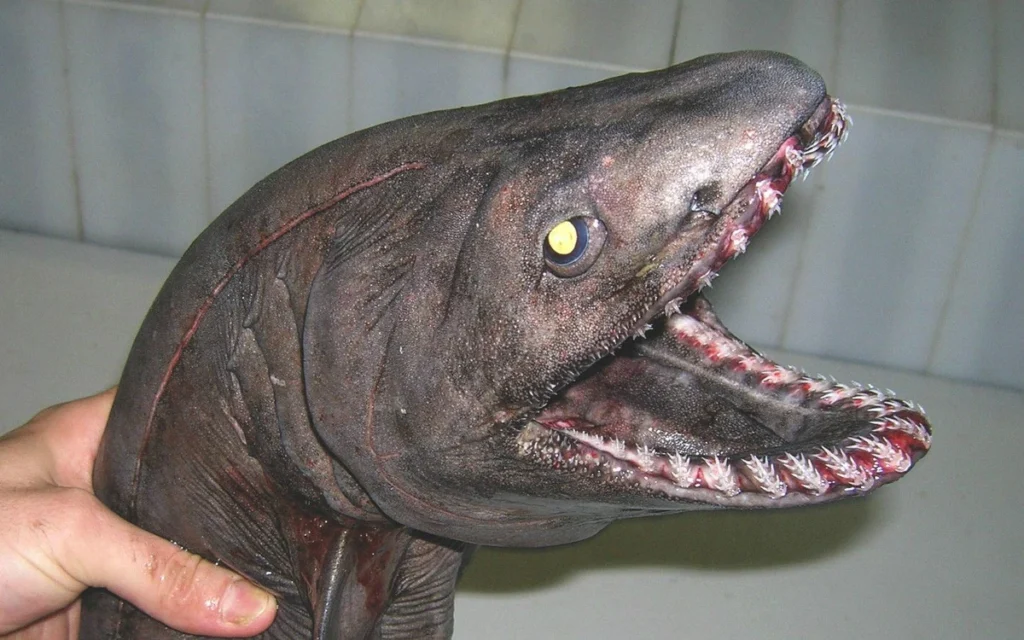 Looking like a cross between an eel and a prehistoric sea monster, the frilled shark has 300 needle-like teeth arranged in 25 rows. It lunges like a snake and can swallow prey whole, thanks to its elastic jaws and distensible stomach.
Looking like a cross between an eel and a prehistoric sea monster, the frilled shark has 300 needle-like teeth arranged in 25 rows. It lunges like a snake and can swallow prey whole, thanks to its elastic jaws and distensible stomach.
Why it’s deadly: Its hunting technique involves ambushing and constricting prey, making it one of the ocean’s more sinister hunters.
5. Anglerfish
Scientific Name: Varies by species
Depth: 200–2,000 meters (656–6,561 ft)
Anglerfish are perhaps the most iconic deep-sea predator, thanks to the glowing lure that dangles from their head to attract prey. Once a victim gets close enough, the anglerfish uses its massive jaw to snap shut in milliseconds.
Why it’s deadly: It uses deception, a glowing lure to bait and ambush prey in total darkness.
6. Giant Squid
Scientific Name: Architeuthis dux
Depth: 300–1,000 meters (984–3,280 ft)
These elusive creatures can grow up to 43 feet long and have eyes the size of dinner plates. Their tentacles are lined with powerful suction cups and sharp hooks. Though rarely seen, they’ve been known to battle with whales.
Why it’s deadly: With incredible size, strength, and sharp tentacle hooks, this creature can overpower almost anything in its path.
7. Deep Sea Dragonfish
Scientific Name: Grammatostomias flagellibarba
Depth: 200–2,000 meters (656–6,561 ft)
Dragonfish might be small, but they’re terrifying. These bioluminescent predators have long fangs, and some species can emit red light, a color most deep-sea animals can’t see. That means they can hunt in invisible light.
Why it’s deadly: It uses invisible bioluminescence to sneak up on prey undetected, a true assassin of the abyss.
8. Black Swallower
Scientific Name: Chiasmodon niger
Depth: 700–2,745 meters (2,297–9,006 ft)
This fish doesn’t have the biggest teeth, but it has one horrifying ability: it can swallow prey 10 times its own size. Its stomach stretches dramatically, and digestion starts before the prey is even dead.
Why it’s deadly: It kills by engulfing prey whole, even if it’s far bigger. Often dies trying, but not before it takes its victim.
9. Cookiecutter Shark
Scientific Name: Isistius brasiliensis
Depth: 85–3,500 meters (278–11,482 ft)
Tiny but terrifying, the cookiecutter shark latches onto its prey and drills out a circular chunk of flesh using its razor-sharp lower teeth. Even submarines and undersea cables have been damaged by these creatures.
Why it’s deadly: It targets large animals, including dolphins and whales, by attacking from below and leaving crater-like wounds.
10. Atlantic Hagfish
Scientific Name: Myxine glutinosa
Depth: 100–1,200 meters (328–3,937 ft)
The Atlantic hagfish is a jawless, eel-like creature that doesn’t look too intimidating at first, but it’s a master of suffocation. When attacked, it releases an insane amount of slime (up to 20 liters in seconds!), which clogs the gills of predators and even kills them. It also burrows into dying or dead animals and eats them from the inside out.
Why it’s deadly: Slime overload can suffocate attackers. It’s also a nightmare for anything already weak or injured in the deep.
Quick Comparison Between Top 10 Deadliest Deep Sea Creatures:
| # | Creature | Scientific Name | Depth Range | Approx. Size | Danger Factor |
|---|---|---|---|---|---|
| 1 | Goblin Shark | Mitsukurina owstoni | 100–1,200 m | 10–13 ft (3–4 m) | Spring-loaded jaws, electro-sensing |
| 2 | Fangtooth Fish | Anoplogaster cornuta | 200–2,000 m | 6–7 inches (15–18 cm) | Huge teeth, ambush predator |
| 3 | Vampire Squid | Vampyroteuthis infernalis | 600–900 m | 1 ft (30 cm) | Bioluminescent escape cloud |
| 4 | Frilled Shark | Chlamydoselachus anguineus | 500–1,500 m | 6.6 ft (2 m) | 300 needle teeth, snake-like attack |
| 5 | Anglerfish | Various species | 200–2,000 m | 8–40 inches (20–100 cm) | Glowing lure, ambush bite |
| 6 | Giant Squid | Architeuthis dux | 300–1,000 m | Up to 43 ft (13 m) | Massive tentacles with hooks |
| 7 | Deep Sea Dragonfish | Grammatostomias flagellibarba | 200–2,000 m | 6 inches (15 cm) | Red light bioluminescence, stealth hunter |
| 8 | Black Swallower | Chiasmodon niger | 700–2,745 m | 10 inches (25 cm) | Swallows prey 10x its size |
| 9 | Cookiecutter Shark | Isistius brasiliensis | 85–3,500 m | 20 inches (50 cm) | Drills flesh chunks from larger animals |
| 10 | Atlantic Hagfish | Myxine glutinosa | 100–1,200 m | 16–31 inches (40–80 cm) | Releases suffocating slime, eats prey from inside |
Why Are Deep Sea Creatures So Terrifying?
Many of these creatures evolved to survive in near-total darkness, freezing temperatures, and extreme pressure. Over millions of years, this created a perfect recipe for stealthy, bizarre, and sometimes horrifying adaptations. From bioluminescence and see-through skin to needle-like teeth and expandable jaws, these predators are a blend of science fiction and evolution at its finest.
How do deep sea creatures survive without sunlight?
They rely on bioluminescence, detritus falling from the surface (marine snow), and eating other organisms to survive.
How do scientists study deep sea creatures?
Researchers use remotely operated vehicles (ROVs), deep-sea submersibles, and baited camera traps to safely observe, photograph, and sometimes capture deep sea life for study.
Are all deep sea creatures dangerous to humans?
Not all, but many have evolved venom or sharp defenses, mainly to protect against predators rather than to attack humans.
What is the latest deep sea predator discovered?
Dulcibella camanchaca, a predatory crustacean from the Atacama Trench, is the newest addition to the deadly deep-sea predators known to science as of 2023.
Where are the deadliest deep sea creatures found?
Many live in trenches like the Atacama or Mariana Trench, but others inhabit dark ocean floors all around the world, from the Pacific to the Atlantic.
While you’re unlikely to run into any of these monsters on your next beach vacation, it’s a little scary to know they exist. These deadly deep sea creatures serve as a reminder of how little we really know about our own planet and how many secrets are still hiding in the dark.


